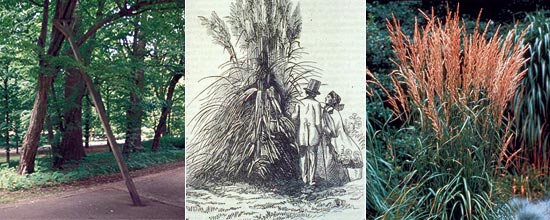

Guidelines for Preserving Cultural Landscapes
Vegetation

Identify, Retain, and Preserve Historic Features and Materials
![]()
Identifying, retaining, and preserving existing vegetation; for example, woodlands, forests, trees, shrubs, crops, meadows, planting beds, vines, and ground covers. Documenting broad cover types, genus, species, caliper, and/or size, as well as color, scale, form and texture.
Evaluating the condition and determining the age of vegetation prior to project work. For example, tree coring to determine age.
Retaining and perpetuating vegetation through propagation using methods such as seed collection and genetic stock cuttings from existing plants to preserve the gene pool.
![]()
Undertaking project work that impacts vegetation without executing an “existing conditions” survey of plant materials.
Undertaking work without understanding the significance of vegetation. For example, removing roadside trees for utility installations or indiscriminate clearing of vegetation.
Failing to propagate vegetation from extant genetic stock, when few or no known sources of replacement are available.
Stabilize and Protect Deteriorated Historic Features and
Materials as a Preliminary Measure
![]()
Stabilizing vegetation by staking, cabling, reinforcing, or other appropriate methods. For example, cabling a tree or limb to protect it against breakage from wind, ice, snow, or age.
Stabilizing vegetation that serves to protect historic or archeological resources.
Protecting vegetation by controlling invasive or inappropriate volunteer plant materials. For example, utilizing mechanized removal, pruning, or approved herbicides.
Protecting below-ground root systems from soil compaction or protecting tree trunks and limbs from damage by equipment such as mowers, weed wackers and plows.
![]()
Failing to stabilize threatened vegetation. For example, permitting the effects of severe weather conditions to damage or destroy vulnerable plant materials.
Removing vegetation from earthworks with subsurface archeological resources or removing large trees that shield marble burial markers from the effects of acid rain.
Allowing invasive vegetation to thrive, leading to the damage and demise of historic vegetation.
Failing to provide adequate barriers or alternative routes to protect significant vegetation from pedestrian, vehicular and heavy equipment traffic.
Maintain Historic Features and Materials
![]()
Maintaining historic vegetation by use of non-destructive methods and daily, seasonal, and cyclical tasks. This may include spring fertilizing, winter mulching or mowing an open field after it has gone to.
Utilizing maintenance practices which respect habit, form, bloom, fruit and color.
Utilizing historic horticultural and agricultural maintenance practices when those techniques are critical to preserving the historic character of the vegetation. For example, utilizing a specific mowing pattern at a country estate.
Rejuvenating vegetation by corrective pruning, deep root watering or fertilizing, aerating soil, and/or grafting onto historic genetic stock.
![]()
Failing to undertake preventive maintenance of vegetation.
Utilizing maintenance practices and techniques that fail to recognize the uniqueness of individual plant materials. For example, rotating crops on an inappropriate schedule, or pruning plants which should be left “natural” into “shapes.”
Employing modern practices when traditional or historic can be used. For example, using a modern textile to control weed growth when a natural material that was used historically is available.
Replacing or destroying vegetation when rejuvenation is possible. For example, removing a deformed and damaged plant when corrective pruning may be employed.
Stabilize and Protect Deteriorated Historic Features and
Materials as a Preliminary Measure
![]()
Stabilizing and protecting circulation features by temporary shoring methods until more permanent methods can be undertaken. For example, installing a temporary timber retaining wall or gabions to halt erosion until a permanent solution can be determined.
Protecting circulation features and materials by monitoring use. For example, restricting access to a prehistoric trail during periods of peak rainfall, or restricting high speed traffic from a leisure drive or parkway.
![]()
Failing to provide stabilization to circulation features. For example, allowing erosion from an unstable slope to cover a drive, ultimately resulting in a new alignment.
Failing to control the volume and intensity of use on circulation systems that results in damage or loss of features or materials. For example, allowing heavy loads on a historic trail.
Limited Replacement In Kind
of Extensively Deteriorated Portions
of Historic Features
![]()
Replacing in-kind a single plant or an entire plant grouping when the vegetation is too deteriorated or damaged to be saved. For example, infilling an individual plant in a windbreak, or perennials in a border, with historically appropriate plant materials.
![]()
Replacing vegetation that is beyond repair with new material when the historic plant is available.
Preservation principles in the Standards have parallels world wide. This tree in a public park in Warsaw, Poland, [top left] was protected and stabilized following a recent storm. (author, 1994) Pampas grass, as depicted in this 1858 engraving, [top center] was often used as a bedding plant. Along the monumental core in Washington, D.C., some of the beds have been replaced in-kind [top right] as a result of their easy availability in the nursery trade.

To provide a basis for later treatment decisions, the existing vegetation within the core area of the Vanderbilt Mansion National Historic Site in Hyde Park, New York, have been inventoried and analyzed. This plan illustrates change in the specimen tree canopy from 1938-1991. For example, lost trees are shown with a black circle, while trees that were introduced are depicted with an “x.” (LANDSCAPES, 1992)